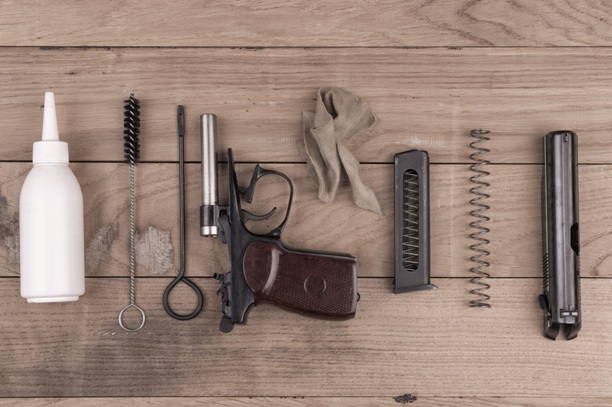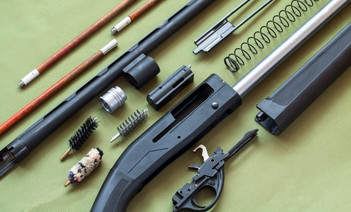Essential Gunsmithing and Gun Maintenance Tools to Keep with a Gun Kit
Jun 4th 2023
Whether you keep a gun kit for the purposes of making repairs to an existing platform on an as needed, ad hoc basis or get a gun kit with the intention of building your own firearm at home, there are some tools you should keep at your bench.
In fact, these are tools that all gun owners should keep on hand, simply for the purposes of administering routine maintenance to most commonly held rifles, shotguns, and handguns.
1. Pin punches (get a set)
Pin punches are an absolute must for any kind of gunsmithing work; realistically they are necessary just for breaking down most firearms for cleaning.
AR upper and lowers are held together by takedown pins, and most trigger groups are held in place with roll pins too.
To disassemble most any rifle or shotgun (and many handguns) you need to punch a few pins.
So get a set of pin punches.
2. Hex keys (get a set)
Scope rings, mounts, and other attachments and shooting accessories often tighten via the aid and interface of a screw or bolt with a hex head.
So get a set of hex keys in various sizes.
3. Torx wrenches (get a set)
Many fasteners on firearms are outfitted with Torx fasteners, so a standard Phillips head or hex driver bit won’t cut it. It’s worth it to have a set of Torx wrenches/bits as well.
4. Other bit drivers
On that note, you might as well just get a set of assorted bit drivers specifically for gunsmithing.
5. Brass and nylon brushes
Stainless steel brushes are great for removing grit and fouling, but there’s a catch. Oftentimes, stainless steel brushes can mar the finish on a gun, scratch the steel, or damage the wood.
So they’re not ideal in most applications. Rather, get a set of nylon or brass brushes. Use the nylon on wood and the brass on aluminum and steel, where it will not leave marks and won’t damage or strip the finish.
6. Brass and plastic hammers
The same maxim that applies to brushes also applies to hammers. Instead of a steel mallet, use a brass or nylon hammer specifically made for gunsmithing so that when and if the head incidentally contacts the receiver or some other portion of the gun, it doesn’t scratch or otherwise damage it.
7. Trigger pull gauge
Most modern firearms come with adjustable triggers. The pull weight can often be adjusted by turning a screw (often with a hex head, see reasons for driver bits, above). This is a simple and straightforward process, but there’s a catch.
But, adjusting the weight is only half the battle, especially for precision shooters. You won’t know what the pull weight is unless you test it. If you want to dial in your pull weight perfectly, you will need a trigger pull weight gauge.
8. Choke wrenches
These are sort of a niche tool, but indispensable for shotguns with interchangeable chokes, and many of them have interchangeable chokes nowadays.
You can improvise a choke wrench but it’s better just to use one designed for the purpose because if you damage the lugs/slots at the front of the choke it can be difficult to remove in the future.
Another note for shotgunners: when cleaning your shotgun, always pull the choke and clean and lube the threads because fouling will get under the threads while shooting, and if you never clean them, the choke tube may become siezed.
9. Gunsmith files
Also helpful to have on hand is a set of gunsmith files with fine teeth. These are used for removing burrs and sharp edges from barrels and receivers after drilling or performing other custom work.
10. Gun vise
Gun vises are not a must but they are useful to have, since it’s difficult to work on a gun when there’s nothing supporting it.
A gun vise will secure your gun and make it easier to work on while freeing your hands, too.
So you don’t absolutely need one compared to these other gunsmithing and maintenance tools, but it’s still nice to have.
11. Magnetic tray
Like a gun vise, a magnetic tray or dish is another nice thing to keep on hand around your bench, although it’s not an absolute necessity.
Although, all in all, these are probably more helpful than gun vises. Place the dish or tray on a metal shelf and when you remove hardware from the gun, place them in the dish.
It will be harder to accidentally tip the dish over if it’s on a magnetic surface, and even if you do, it won’t scatter all the small parts.
12. Magnetic retrieval tool
No notes here; a magnetic retrieval tool can help make it easier to get back scattered hardware, if you drop a metal piece somewhere that’s hard to access.

If Finishing a Receiver and Assembling with a Gun Kit: A Jig and Router
Last but not least, if you are making a firearm at home for personal use from a receiver blank and a build kit or parts kit, you should also have a jig that fits the blank as well as a router or a drill press and the appropriate bits to finish milling out the receiver.

